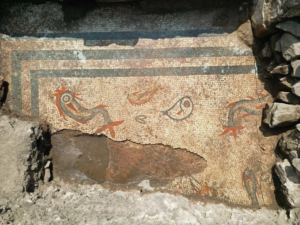 Archaeologists have unearthed a well-preserved mosaic, dating back nearly 2,000 years, at Wroxeter Roman City in Shropshire, England.
Archaeologists have unearthed a well-preserved mosaic, dating back nearly 2,000 years, at Wroxeter Roman City in Shropshire, England.
This ancient site, originally known as Viroconium Cornoviorum during Roman times, was once the fourth-largest settlement in Roman Britain, rivaling the size of Italy’s Pompeii. The city, established in the 1st century CE, was strategically located to protect the River Severn valley and served as a crucial frontier post during the Roman campaigns led by General Publius Ostorius Scapula.
The mosaic, which vividly depicts dolphins and fish in striking white, red, blue, and yellow colors, was found during recent excavations led by English Heritage, in collaboration with the University of Birmingham, Vianova Archaeology & Heritage Services, and Albion Archaeology. The discovery was made in a high-status townhouse along Wroxeter’s main road, where archaeologists also uncovered a large civic building and a shrine or mausoleum.
Win Scutt, senior properties curator at English Heritage stated, “Our excavations were in hope of discovering the walls of this building, but we never suspected we would find a beautiful and intact mosaic, which had lain hidden for thousands of years. It’s always an astonishing moment when you uncover a fragment of beauty hiding just below the ground.”















